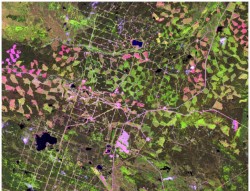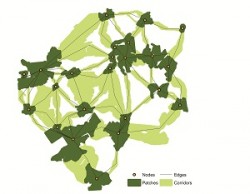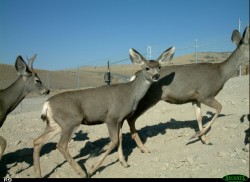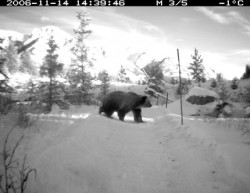News & Media
Landscape connectivity: corridors and more, in Issues in Ecology #16

A team of researchers, managers, and ecological risk assessors review the current state-of-the-art in landscape connectivity planning, offering models, case studies, and advice for coping with the uncertainty inherent in dynamic, real-world conditions in the Ecological Society of America’s 16th volume of Issues in Ecology.
Connectivity doesn’t always mean corridors

Connections can be conduits, or more complex extensions of habitat, looking more like a web than a greenbelt. Coastal inhabitants need the depth of the reach of tides as well as the horizontal reach of coastline habitat. Birds may be able to hop from preserve to pea-patch to backyard oasis, depending on their range and flexibility.
The need to move is most obvious for migratory animals and the large animals that need big tracts of territory. Most of us are aware of large and charismatic animals like deer, bear, or coyotes. But plants, and smaller, less itinerant animals, also benefit from connections to wider spaces.
“Landscape connectivity is as diverse as the animals that live in it,” said lead author Deborah Rudnick, an environmental scientist with Integral Consulting Inc, in Seattle, WA.
On the ground, managers need to address the biology of their focal species, understanding behavior, genetics, adaptation, and habitat. They have to scale up observational and experimental data to predict interactions with other wildlife and physical features of the landscape, layering on the possibility of climate changing, waterways shifting, and human life encroaching.
“It’s a massive amount of info to keep in your head simultaneously. I want people to step away from this review with a sense of that complexity,” said Rudnick.
No Perfect Solutions

Some planners prefer to focus on preserving ecosystem services, rather than specific species, in an effort to preserve an ecological community more holistically. But there is no perfect solution. Unpredictable future conditions are unavoidable complications to conservation efforts, and climate change in particular could throw a ringer into the best laid plans.
“We are no longer living in a world where we can preserve perfect habitat,” said Ryan.
Climate change means wildlife will move – unpredictably

“We’re seeing species moving to new territory independently, remixing existing communities and shaking conservation definitions,” said Rudnick. “What do we mean by quote-un-quote conserving a community? What does it mean in the face of climate change? You cannot expect a community to stay in the place that it was in the face of major changes in their environmental conditions.”
Our models, and management, must adapt to conditions changing in real time. Flexibility is not generally a virtue of government regulations. The timescale of legal decision-making is generally much shorter than we would want in order to provide communities, both ecological and anthropological, time to adjust.
Achieving connections for wildlife requires forging connections with people

A first step is finding a common language. Ryan saids she doesn’t talk about ‘ecosystem services’ in rural Uganda. Those aren’t Rutooro words. “We ask, “Is the park beneficial to you?”” and locals might say, “It keeps the rain.” They perceive benefit from the park, but don’t describe it like a scientist. The same is true of English-speaking communities.
You build your models, said Rudnick. “Then you try to put them in the real world. Community needs—that is, human community needs—add a whole layer of complexity to real life implementation.”
![ARC [diagram]](https://arc-solutions.org/wp-content/themes/arc/images/arc-diagram.jpg)
